Apple's iPhone 4: Thoroughly Reviewed
by Brian Klug & Anand Lal Shimpi on June 30, 2010 4:06 AM EST- Posted in
- Smartphones
- Apple
- iPhone 4
- Gadgets
- Mobile
FaceTime
Meet Manveer. I’ve known him since I was in the 6th grade. Somewhere around the 8th grade we started a ritual of calling each other every day after school and talking about video games, computers and dumb things that happened at school. We talked on the phone for hours. Back in those days we would even play the same game on separate computers while talking on the phone. It was a precursor to voice chat in gaming networks like Steam or Xbox Live. It was ridiculous amounts of fun.
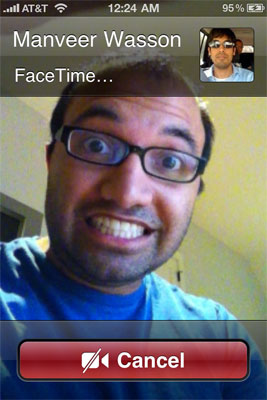
Manveer is up in the corner, the crazy guy is yours truly
Tonight Manveer and I FaceTimed. It’s the feature I wish we had when we were back in middle school. These days it’s a lot harder to explain why you’ve got some random dude’s face on your phone talking to you about completely pointless things at 12:54AM on a Tuesday night. I spent part of the chat covering one of the lights in my room with my head and calling it an Anand Head Eclipse. At the risk of further embarrassing myself publicly, it was fun.
For those of you who don’t know, FaceTime is Apple’s VoIP protocol built into the iPhone 4.
Granted we’ve been able to do this sort of thing for quite a while now over instant messenger networks. Integration into your smartphone is just the next logical step, and in the right conditions it works very well.
 |
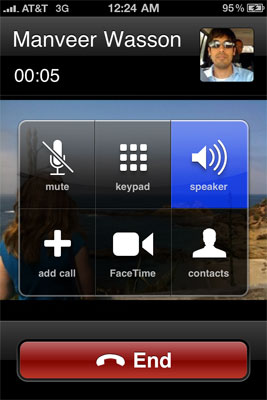 |
The first requirement is that both users need to have an iPhone 4 obviously. Both also need to be on WiFi. While the FaceTime icon will appear if you call another iPhone 4, if you try to activate the connection you’ll get this error unless you’re on WiFi:
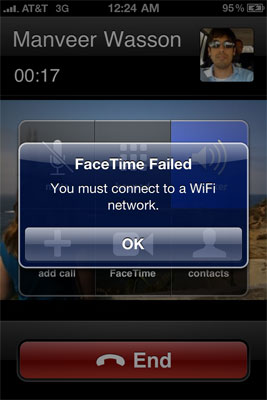
With a bit of poor UI design Apple will actually display a FaceTime icon with a question mark in it if you call another iOS phone. Trying to activate FaceTime however gives you an error.
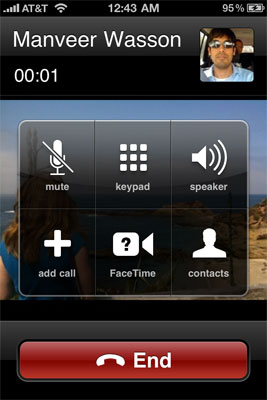 |
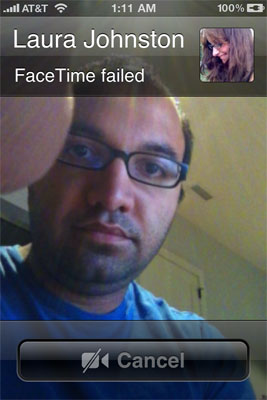 |
FaceTime requires roughly 100 - 150Kbps of bandwidth in both directions to work smoothly. The download should be fine but the upload is pretty high given that many broadband providers in the US are ridiculously stingy with their upload bandwidth. For FaceTime to work well you can’t be uploading or downloading anything large in the background, or if you are just throttle everything else to give you enough bandwidth to work with.
The next problem with FaceTime is the iPhone 4 lacks an absolutely necessary integrated stand. HTC got it perfect with the EVO 4G, unfortunately the 4 has no such thing. The closest you can get is Apple’s iPhone 4 dock, it’ll set you back $29 but it’s necessary to prevent you from getting tired holding your phone out in front of you. Laying the 4 down on your desk while you FaceTime just gives the person on the other end of the line a great view of your nostrils. Not very welcoming.
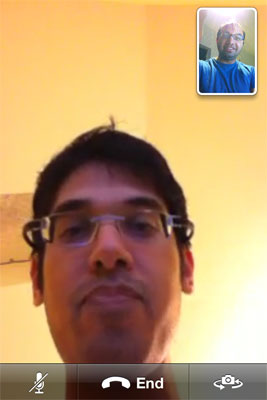
This is the on-table view of FaceTime, you need a stand
Even once you’ve met all of the requirements it’s still not a guaranteed thing. Even with ample bandwidth I had one FaceTime chat stall in the middle of the chat. My incoming feed froze and I had to wait a couple of seconds for it to resume. I also had a problem where FaceTime would fail to start on the first try. A subsequent try fixed it.
As you'll see in our camera investigation, the low light performance of the 4's front facing camera is horrid. Couple that with FaceTime and you will get bad image quality if you're not in a well lit room:

Ugh, what is this, 1998?
While in FaceTime you can easily switch between front and rear cameras by tapping the camera icon in the lower right corner. Unfortunately the compression on the video is enough to render text illegible while in FaceTime:
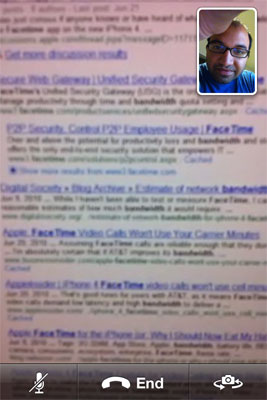
This was taken using the rear facing camera over FT
Obviously everyone knows where FaceTime is going. Apple is supposedly opening the protocol up to all developers, so you’d be able to theoretically build desktop and other smartphone FaceTime clients. And ultimately as mobile broadband speeds (hello WiMAX and LTE) improve the WiFi requirement will be dropped. But is it a good feature today?
It really depends on who you know with an iPhone 4. If you’ve got a Manveer, absolutely - the feature is worth it. If you have a bunch of casual acquaintances with iPhone 4s, probably not. It’s only useful if you know the person on the other side very well.
There is one other major benefit to FaceTime. Once enabled your call is routed over WiFi to the Internet, not AT&T’s 3G network. It doesn’t use any of your plan’s minutes and more importantly, voice quality is much improved over a regular 3G/EDGE phone call. It’s VoIP, not a crappy cell connection. Even if you just cover the camera it’s actually better to make calls over FaceTime than 3G based on the sound quality alone.










270 Comments
View All Comments
strikeback03 - Tuesday, July 6, 2010 - link
How does international work? Are other parts of Europe covered by that as well or are they all additional?B3an - Thursday, July 1, 2010 - link
Theres way WAY less options for network and internet providers in the U.S, especially compared to here in the U.K..So less competition means higher prices. And of course the size of the U.S/Canada is a problem.
strikeback03 - Thursday, July 1, 2010 - link
Some friends who have been living in England say that cell usage over there is way more expensive. They claim the only affordable way to do it is with pay as you go SIMs and just not use them much.But yes more competition would be nice. For me Verizon is the only carrier that offers the kind of coverage I need. So between the fact that I can't go anywhere and that they don't offer an off-contract rate I have no reason not to take the subsidized phones and contract extensions.
Chissel - Sunday, July 4, 2010 - link
I'm an American living in the UK. iPhone 4 rates here are much lower. The best I have seen is from Tesco (o2 network). Low cost no frills service. 750 minutes + unlimited texts + 1gb of data per month. Also, incoming calls do not charge minutes. 1 yr. contract 32gb iPhone 4 = £299/$450 + £35/$50 per month (all tax included). After 1 yr. they have to unlock your phone. After you unlock the phone you can drop down to £20/$30 per month.This means the 2 year cost of the phone + service in the UK is £959/$1,438. In the US the 2 year cost is $299 + tax and $105/mo + tax. Total cost over 2 years is $2,819 without tax.
As you can see the UK has much lower price over the 2 years. Plus, after 1 year you 'own' your phone and can resell and buy iPhone 5.
strikeback03 - Tuesday, July 6, 2010 - link
I think the unlock on AT&T can be requested after 3 months, definitely after a year as I had a friend do that.StormyParis - Saturday, July 3, 2010 - link
I've abandonned data plans, and switched back to plain voice, on my HD2. I get Wifi most everywhere (at home and at work for sure, and most places in between). I was simply not using data that much, it's not worth the monthly 30 euros they want for it.99.5% of the time, there's no difference at all. 0.5% of the time... i can survive...
vol7ron - Wednesday, June 30, 2010 - link
I agree, but..."The fact that Apple didn't have the foresight to coat the stainless steel antenna band with even a fraction of an ounce worth of non-conductive material either tells us that Apple doesn't care or that it simply doesn't test thoroughly enough. The latter is a message we've seen a few times before with OS X issues..."
Apple would just see this as another selling point for the bumper.
Anand/Brian-
I'm curious if you've had a chance to test with the microfilm covers like Bodyguardz or Zagg.
I use these because of how thin they are and how great they are at protecting the device (scratch free even when dropping on concrete). They cover all points of the phone rather effectively. I'm curious if they would be beneficial to your testing.
vol7ron
Brian Klug - Wednesday, June 30, 2010 - link
vol7ron,You're totally right, I need to test with a thin film or some heavy duty tape/invisible shield. I originally thought of doing that, but somehow it got lost in all that frenzied testing. I'll whip something up and see if anything changes. I mean that's a good point too, it might not do very much.
I mean, ultimately there's a thickness you do need to achieve, and to be fair a lot of the benefit the case adds is that extra couple mm or two from the antenna. If the film is too thin, it might not do much. What makes me uneasy about saying anything definitively is that this is so near field - literally on top of the radiative surface. I'll admit I have only a basic level of understanding about what kind of interference happens in the very near field. I mean even at 1.8 GHz, one wavelength is 16 cm - the case and your hands on the phone is way inside near field.
-Brian
rainydays - Wednesday, June 30, 2010 - link
Agree. Outstanding review. The detailed analysis and level headed tone is excellent. Keep up the great work.Antenna section was illuminating. Good point about using SNR. I wonder if that number by itself is sufficient though. I guess signal power in dbm along with SNR would give the most complete picture of reception.
At any rate, as is abundantly clear in the article, you never really know where you are till you see the numbers.
John Sawyer - Thursday, July 1, 2010 - link
Yes, the numbers, details, etc. are more important than a lot of people realize. It often annoys me when I see people commenting about issues that involve actual measurement, technical facts, etc., without referring to any of those, and thus winding up with all kinds of conspiracy theories, bogus suggestions, etc. As applied to hardware problems from any manufacturer, generally many such commenters, in their understandable desire to just see a fix for a problem, wind up suggesting the only important thing is for the manufacturer to set up a return exchange program, which would be nice if it were always that easy, but it doesn't address the details of the problem that are often quite interesting, and can be very useful for people trying to learn from the situation.